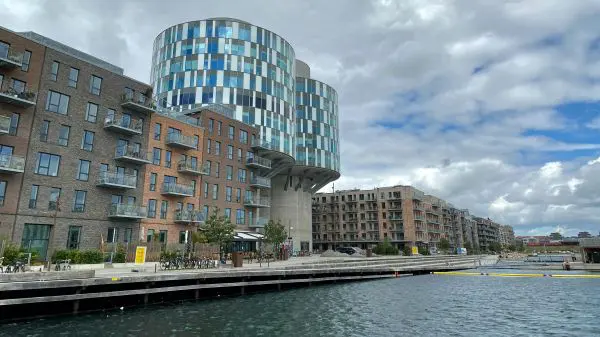Forget the 15-minute city – Nordhavn wants you to have everything you need in five
Posted on: 5 May, 2025

An old industrial harbour in Copenhagen has become the centre of the city’s plans for a sustainable future. Here’s how it plans to offer its residents access to all their needs within a five-minute journey.
It’s hard to imagine discussing the concept of the 15-minute city without eliciting strong reactions. While the idea seems innocent enough – changing the layouts of cities to give residents easier accessibility to the amenities they need – it’s become entangled in significant controversy, being viewed by some as a totalitarian plot to infringe on personal freedoms.
Yet while in the UK and USA this urban planning policy has been met with a mixture of jubilation and resistance, in other parts of the world it’s been fully embraced to great effect. In fact, over in Denmark, work is underway to take the concept to the next level – the five-minute city.
Nordhavn and the birth of the five-minute city
Nordhavn, or Nordhavnen, is a harbour in Copenhagen. Founded in the 19th century, it was once the industrial neighbourhood of the city, but since 2009 work has been underway to turn it into a thriving city district.
At just 2km2 (roughly the size of 625 football grounds), it’s far from being on the same scale as other municipalities around the world that have adopted Carlos Moreno’s 15-minute model – take Paris or Barcelona, for example. However, this small harbour has become the centrepiece of Copenhagen’s plans for sustainable development.
How Nordhavn will make the five-minute city a sustainable reality
There are several themes in Nordhavn’s development that are helping it achieve its sustainability and urban planning ambitions:
Mixed-use development
Mixed-use spaces are buildings and properties that serve multiple purposes – for instance, one building can simultaneously be divided into residential accommodation, leisure facilities and commercial spaces.
This idea aligns closely with 15-minute cities, as it naturally grants easier access to essential facilities, reducing the need for people to travel. It’s no surprise, then, that Nordhavn has adopted this approach.
Learn more: Are mixed-use developments the future of construction?
Sustainable transportation options
Minimising the need for residents to use private transportation is at the core of the 15-minute city model. Alongside providing easy access to amenities, Nordhavn has moved to make streets pedestrian and bike-friendly to encourage more sustainable methods of transportation.
Similarly, Nordhavn’s master planning has worked to make the use of electric vehicles and sustainable public transportation as easy and convenient as possible.
Renewable energy sources
City districts and centres like Nordhavn are typically where most energy is consumed, with these spaces responsible for around 70% of all energy consumption. To mitigate this, Nordhavn is working to make the area carbon neutral through the use of geothermal energy, solar panels, district heating and district cooling.
It also boasts the world’s largest heating storage facility, which can store surplus heat for use as energy during cold winters.
Smart city infrastructure
This small district is also adopting elements of another emerging model in sustainable development – the smart city. The idea behind this is that, through connected technologies like the Internet of Things and artificial intelligence, cities can drive greater efficiency and reduce resource wastage.
In the case of Nordhavn, traffic management, waste solutions and smart building design are being used to help lower the district’s carbon footprint.
Learn more: What are smart cities (and are they the future of the built environment)?
Green spaces
Green spaces like parks, mini-forests and architecture that incorporates biophilic design bring a wide range of sustainability benefits, from reduced carbon and noise pollution to improved air quality and human health.
These urban spaces are an essential component of sustainable landscapes, and as such Nordhavn offers plenty of green spaces and waterfront locations to capitalise on these benefits and encourage social interaction and physical activity.
Final thoughts
While urban planning models like the 15-minute city are being met with resistance in some parts of the world, in others they’re opening up the possibilities of a future that benefits both people and the environment. There are few better examples of this than Nordhavn.
As Jacob Deichmann, Ramboll project manager and architect, commented:
“Nordhavn provides the opportunity for 40,000 people in Copenhagen to have nature at their doorstep – right in the centre of the city. Its neighbourhood design drastically rethinks how cities can combine different ways of living with sustainable energy, environment, mobility, and cityscape solutions.”
Urban planning is an exciting field that has a pivotal role in the design and function of our cities and communities. If you want to have a part in helping the built environment realise a sustainable future, UCEM’s MSc Urban Planning will give you the knowledge, skills and technical understanding you need.
Find out more: MSc Urban Planning – University College of Estate Management





